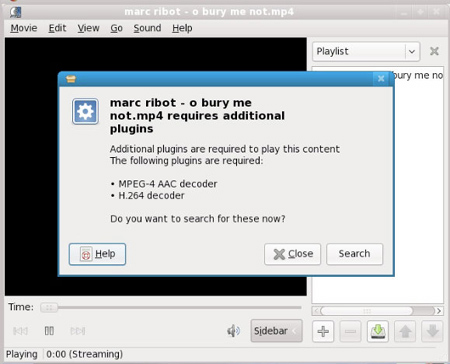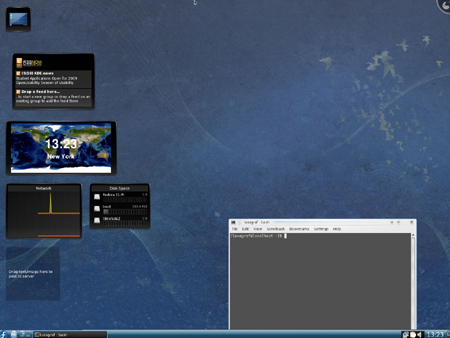Original URL: https://www.theregister.com/2009/06/09/fedora_11_review/
Fedora 11 leaps into filesystem unknown
Data vanishes along the way
Posted in OSes, 9th June 2009 19:38 GMT
Review It seems like Fedora 10 came along just yesterday, but already Fedora 11 is here.
If the quick turnaround time smacks of the sort "upgraditis" that proprietary operating systems push on users, fear not. Fedora isn't trying to reinvent the wheel every six months.
Instead, the move from Fedora 10 to 11 promises to carry on with the same, solid tradition of the Fedora line. There are a handful of new features, many updates to improve existing functions, and some under-the-hood improvements.
Goes too far?
Of course, it wouldn't be a Fedora release if there wasn't one giant leap into the unknown. And Fedora 11 does include some bleeding-edge technologies, including one that some might argue is too bleeding edge: the ext4 filesystem.
Fedora 11 is the first major Linux distro to make the move to ext4. While the most recent release of Ubuntu included support for ext4, Canonical opted to leave ext3 as the default choice. The Fedora project however, is plowing ahead, and unless you configure it otherwise, Fedora 11 will install ext4.
Ext4 offers huge advantages over its predecessor and borrows some of the best features of other file system types - like the new delayed allocation function, which was inspired by features in the ZFS file systems. However, the same feature is also a source of some very serious data loss problems.
Technically, the problem has nothing to do with ext4 and rests squarely on applications that don't use POSIX recommended fsync() or fdatasync() functions to write files to disk. In developers' defense, ext3 didn't handle fsync() very well and a common way to speed up an app was to remove fsync() and do straight saves to disk. However, that shortcut is coming back to haunt some in the form of lost data.
The main source of pain appears to be in the Ubuntu community, though it will be interesting to see what happens now that Fedora 11 is taking the ext4 plunge.
I opted for the default GNOME install of the Fedora 11 Preview Release, and thus far, I've had no problems with lost data or any other significant issues. In fact, like its predecessor, Fedora 11 is fast, rock solid, and fun to use.

Automatic installer: PackageKit gets its hooks into firmware
Among the major new features in this release are updates to the desktop environments - GNOME is now at 2.26 release candidate and the KDE flavor is using 4.2.1 - and a very helpful upgrade to one of our favorite Fedora features: PackageKit.
PackageKit is a software-discovery tool that lets you quickly and easily install the bits you need to open a file. For example, if you download a PDF file but don't have a PDF viewer installed, PackageKit notices that and offers to install the software you need. It makes for a much smoother Linux experience, and since PackageKit is a generic, distro-agnostic framework, we're surprised more distros haven't taken advantage of it the way Fedora does.
Fedora 10 laid the groundwork for PackageKit and included support for the automatic installation of multimedia codecs when you opened an mp3 or other music file. With Fedora 11, that same automation moves to the world of firmware, prompting you to install the drivers you need by checking the system requirements and then offering to download the best firmware option for your system.
The process is about as simple and easy as you could hope for when it comes to getting your video and devices working in Linux.
Fedora 11 also builds on another feature from version 10, adding some more advanced features in the PulseAudio sound server. The most noteworthy improvement is the new support for per-application volume control - perfect for toning down IM alerts when you're listening to music.
Boot me up, shut me down
One of the Fedora Project's major goals for this release was to make boot and shutdown times much faster. Fedora 11 claims to be at the login screen in 20 seconds. In my testing, Fedora 11 actually beat the goal by a couple of seconds and shutting down was even faster, usually taking just over 10 seconds to power the system off.
Much of the speed gain at boot was made possible by removing what the Fedora Project refers to as "bloated tasks" from the boot process. I was a little suspicious that those might have been handed off after login - meaning to the GNOME-session - but thankfully, logging into GNOME is just as quick as ever.
There's also a grab bag of smaller improvements in Fedora 11, like a better out-of-the-box experience for systems with fingerprint readers, stronger hashes (SHA-2, rather than just MD5 or SHA-1), and a new way for desktop programs to automatically install items such as applications, fonts, and multimedia codecs.
Developers will be happy to know that the latest version of Fedora ships with a number of improved tools including GCC 4.4 and even Python 2.6.
As for the applications, Fedora includes Firefox 3.5 - although it was still labeled as 3.1b3 in the preview release - the new OpenOffice 3.1, Rhythmbox, and a few of the other usual GNOME suspects like GIMP, the F-Spot photo manager, Pidgin, and Transmission.

Bit of a looker: KDE in Fedora 11 finally beats GNOME
On the KDE side, you'll find all the improvements of version 4.2 - including support for Plasma widgets, the latest version of Dolphin file manager that has now matched most of Konquerer's feature-set, and updates for the KDE app suite like KMail, Kontact, KDevelop, and KWrite.
I've avoided KDE during the jump from 3.5 to 4.0, but now that 4.2 is here, the four-series KDE desktop finally feels mature enough for everyday use and in many respects - especially the eye-candy - it trumps our old friend GNOME. But KDE did take considerably longer to login to than GNOME. It appears there's a price to pay for the fancy graphics, and you'll likely notice it more with Fedora 11's very short boot times.
Performance-wise, Fedora 11 is plenty snappy. Of course, the speed will vary greatly according to your PC's specs, but aside from the faster boot times - which are very noticeable - I didn't notice a huge change over Fedora 10. I only encountered one persistent bug in the preview release, which would cause the audio subsystem to go haywire every once and while, and hope this has now been fixed.
Take the leap
If you've never given Fedora a try, now is a great time. Not only does the latest version continue Fedora's tradition of slick and stable releases, it packs in enough nice new features to make it well worth the upgrade. And for those who aren't sold on using the ext4 filesystem, it isn't hard to install with ext3.
I would definitely recommend Fedora 11 to anyone using 10, but think it might also be a nice alternative for those growing tired of Ubuntu or just looking to play around with a new Linux distro. ®